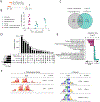Prolonged STAT1 activation in neurons drives a pathological transcriptional response
- PMID: 37556887
- PMCID: PMC10527980
- DOI: 10.1016/j.jneuroim.2023.578168
Prolonged STAT1 activation in neurons drives a pathological transcriptional response
Abstract
Neurons require physiological IFN-γ signaling to maintain central nervous system (CNS) homeostasis, however, pathological IFN-γ signaling can cause CNS pathologies. The downstream signaling mechanisms that cause these drastically different outcomes in neurons has not been well studied. We hypothesized that different levels of IFN-γ signaling in neurons results in differential activation of its downstream transcription factor, signal transducer and activator of transduction 1 (STAT1), causing varying outcomes. Using primary cortical neurons, we showed that physiological IFN-γ elicited brief and transient STAT1 activation, whereas pathological IFN-γ induced prolonged STAT1 activation, which primed the pathway to be more responsive to a subsequent IFN-γ challenge. This is an IFN-γ specific response, as other IFNs and cytokines did not elicit such STAT1 activation nor priming in neurons. Additionally, we did not see the same effect in microglia or astrocytes, suggesting this non-canonical IFN-γ/STAT1 signaling is unique to neurons. Prolonged STAT1 activation was facilitated by continuous janus kinase (JAK) activity, even in the absence of IFN-γ. Finally, although IFN-γ initially induced a canonical IFN-γ transcriptional response in neurons, pathological levels of IFN-γ caused long-term changes in synaptic pathway transcripts. Overall, these findings suggest that IFN-γ signaling occurs via non-canonical mechanisms in neurons, and differential STAT1 activation may explain how neurons have both homeostatic and pathological responses to IFN-γ signaling.
Keywords: Cytokine; Interferon-gamma; Neuroimmunology; Neuron; STAT1.
Copyright © 2023 Elsevier B.V. All rights reserved.
Conflict of interest statement
Declaration of Competing Interest AJF has intellectual property that has been licensed to Cryocell.
Figures






References
-
- Benjamini Y, Hochberg Y. Controlling the False Discovery Rate: A Practical and Powerful Approach to Multiple Testing. Journal of the Royal Statistical Society: Series B (Methodological). 1995;57:289–300.
Publication types
MeSH terms
Substances
Grants and funding
LinkOut - more resources
Full Text Sources
Molecular Biology Databases
Research Materials
Miscellaneous

